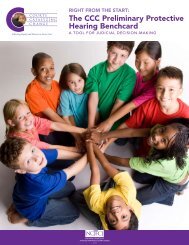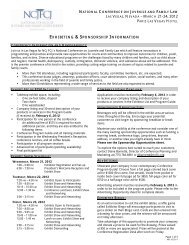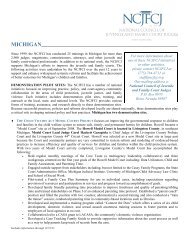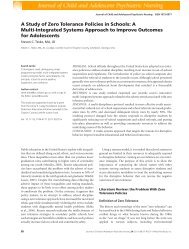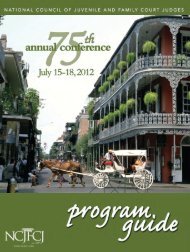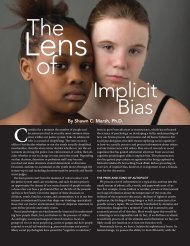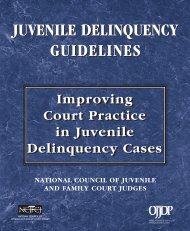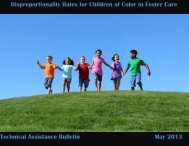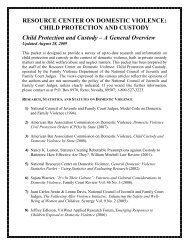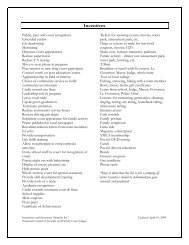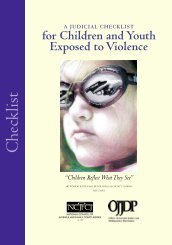EDUCATION UNDER ARREST: - Justice Policy Institute
EDUCATION UNDER ARREST: - Justice Policy Institute
EDUCATION UNDER ARREST: - Justice Policy Institute
- No tags were found...
You also want an ePaper? Increase the reach of your titles
YUMPU automatically turns print PDFs into web optimized ePapers that Google loves.
28 JUSTICE POLICY INSTITUTEtraining experienced a 39 percent decrease insuspensions, compared to a 14 percent decreasein suspensions in Tennessee overall. 116Tennessee remains a model for the U.S.Department of Education.Restorative justice: Restorative justice practiceshave been found to have a number of benefits,especially for youth. Youth who havecommitted an offense but participate inrestorative justice programs are less likely tocommit another offense 117 and people whoexperience harm are more likely to report beingsatisfied with the outcome than people thatwent through a typical court process. 118Restorative practice empowers people toresolve conflict or harm themselves, withoutinvolving law enforcement or the justicesystem. It can take a number of forms, butusually includes conferences, conversations,meetings of involved parties and thecommunity affected or peer mediation. 119Within a school, similar principles and practicescan be used to avoid arrests and help restorepeople who have experienced harm. In a reviewof restorative practices in six schools inPennsylvania, the International <strong>Institute</strong> forRestorative Practices found that the schoolsexperienced decreases in incidents of violence,assault, and disorderly conduct, and decreasesin detention and suspension. One school, WestPhiladelphia High School was dubbed“Persistently Dangerous,” but after theimplementation of restorative practices,experienced a 60 percent decrease in assaults onstudents and a 72 percent decrease in incidentsof disorderly conduct. 120Restorative practices in schools should be usedwithin the context of other holistic, school-widesupportive approaches to managing behavior inschool and addressing student behavior. Forexample, restorative practices would be used injunction with PBIS as the last resort when anincident does occur. 121FOR THE COST OF AN SRO, WE COULD GET….Federal funding cuts, local budget constraints, and pressure to ensure quality education for all studentsgives school districts the opportunity to consider what else could be paid for with the money spent on asingle SRO.According to the COPS handbook, a police officer can be promoted to detective when they become anSRO (this is an incentive to encourage more officers to become SROs). The median salary of adetective in the U.S. in 2011 is $63,294, comparatively a school counselor’s median salary is $61,446.But, comparatively, a counselor is paid $71,070 and a teacher is paid 52,471. Neither of thesepositions carry with it the collateral costs outlined above that are related to SROs and zero tolerance.For the salary of a single SRO, a jurisdiction, could hire one teacher and payfor approximately 20 percent of the salary of a second teacher.RoleMedian SalarySchool Resource Officer (Detective salary) $63,294School Psychologists/Counselors $66,810School Nurse $44,006Principal $86,970Teacher (secondary education) $52,471Special Education Teacher $52,446Source: Bureau of Labor Statistics, “Table 7: Full-time local government workers: Mean andmedian hourly, weekly, and annual earnings and mean weekly and annual hours,” June 7,2011. www.bls.gov/ncs/ocs/sp/nctb1481.pdf, Bureau of Labor Statistics, “Table 19-3031,“Occupational Employment and Wages, May 2010, Clinical, Counseling, and SchoolPsychologists,” August 11, 2011. www.bls.gov/oes/current/oes193031.htmSalary.com, “School Nurse Median Wage,” October 14, 2011. www1.salary.com/School-Nurse-Salary.html#JD



